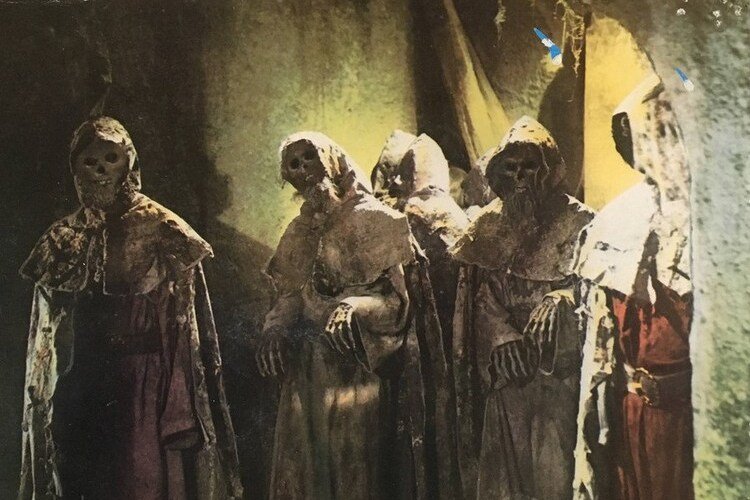TOMBS OF THE BLIND DEAD: A Sacred Knight Of Spanish Terror
If you ask a Euro-horror fanatic about the key titles of Spanish horror cinema, the Blind Dead film series will inevitably be mentioned. This quartet of films directed by talented journeyman Amando De Ossorio rank up there with the work of Paul Naschy and Jesus Franco, spinning out a fascinating mythology connected to Spain's history and using their distinctive ghostly villains, the Knights Templar, as a vehicle for commentary on the real-lifes horrors of Spanish life under the reign of General Franco.
Tombs Of The Blind Dead was the first film in the series and gradually lays out the elements of the series mythology in the form of a supernatural mystery story. It begins with the accidental reunion of Virginia (Maria Elena Arpon) with former classmate Betty (Lone Fleming) while Virginia is on vacation with her beau Roger (Cesar Burner). The two women have unfinished romantic business between them - and when Roger expresses interest in Betty, Virginia ditches the train they are on to camp out in the ruins of an old monastery.
When Virginia does not return, Betty and Roger go to the ruins to investigate. What they don't know is Virginia was the victim of a group of skeletal zombies in ancient robes who mauled her and drank her blood. The protagonists will ultimately discover they are the undead Knights Templar, a band of warriors who returned from the Crusades corrupted by black magic. Though they were executed centuries ago, their bloodlust is resurrected when Virginia becomes their victim - and their resurrected campaign of terror threatens to spread like a plague.
To modern eyes, Tombs Of The Blind Dead can seem rough around the edges. De Ossorio's pacing is seldom aggressive and his storyline has an unorthodox structure that has two major peaks of horror separated by a lot of plot and dialogue leavened with a few smaller scares. There is also an uncomfortable scene where a rape is played for sleazy eroticism (word has it this is how they got sexual content past strict Spanish censors). Most importantly, while the film is full of imaginatively creepy concepts, it never quite figures out how to get the most out of them in a way that later films in the series would.
That said, such complaints are easily forgiven for Euro-horror fans because its many good ideas are really strong. The Knights are both creepy and pictureseque villains: the imagery of them riding through the countryside on ghostly steeds is unforgettable stuff. The film also cleverly mixes its Templar concepts, rooted in Spanish history, with elements of then-modern horror, like how their victims can rise up as bloodthirsty zombies a la Night Of The Living Dead. There is also a chilling scene where the Knights, who are blind, track a potential victim by listening for their heartbeat.
Finally, if you learn about the socio-political climate in Spain during the early '70s, you might notice a unique subtext to Tombs Of The Blind Dead. Using the language of horror, the film creates an interesting tension between youthful heroes trying to explore everything life has to offer and a repressive past whose horrors are both undead and vengeful, snuffing out any living soul in arm's reach. It's easy to connect that ancient evil with how General Franco's fascist ideas cut through all levels of Spanish life at that time - and that's a pretty gutsy theme to smuggle into a commercial horror flick.
In short, Tombs Of The Blind Dead remains a landmark in Spanish horror and an effective foundation that De Ossorio would build upon with later films. If you're looking to take a tour through Spanish horror, it's a necessary stop.




